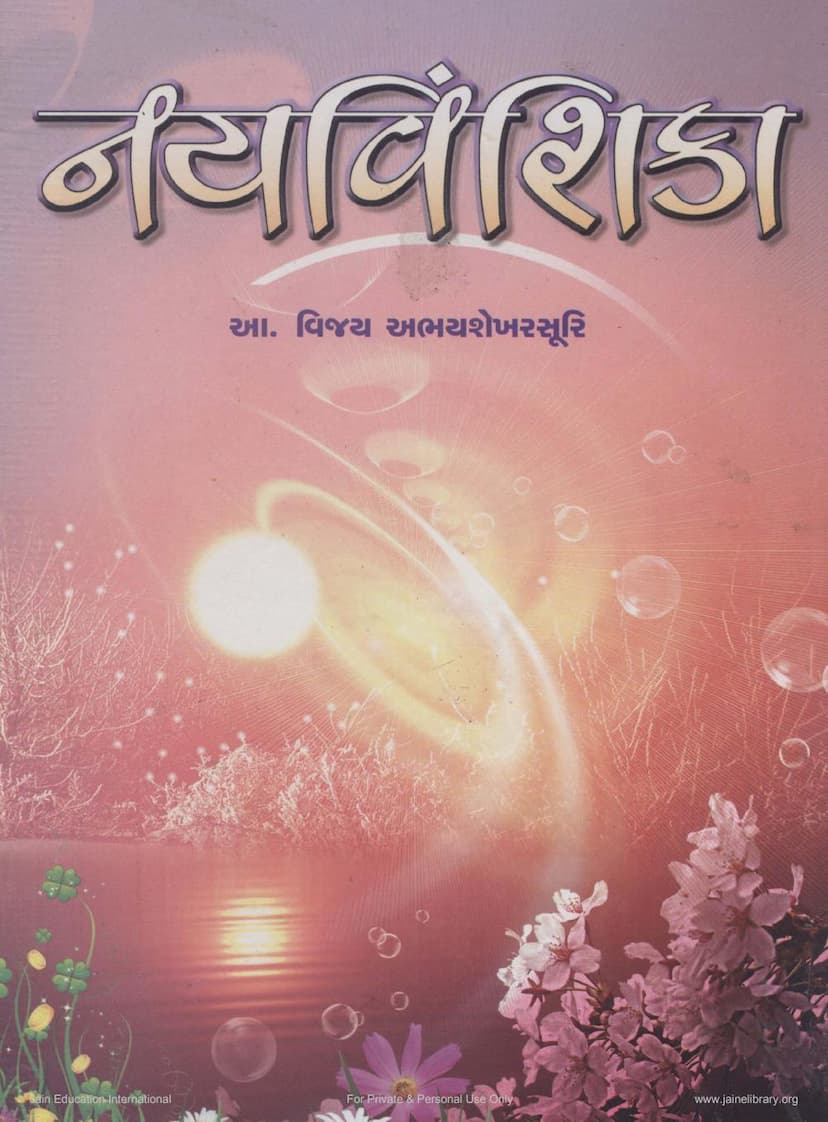Nayavinshika
Added to library: September 2, 2025

Summary
Here's a comprehensive summary of the Jain text "Nayavinshika" by Acharya Vijay AbhayShekhar Suri, based on the provided pages:
Title: Nayavinshika (नयविंशिका) Author: Acharya Vijay AbhayShekhar Suri Publisher: Divya Darshan Trust
Overall Purpose:
The book "Nayavinshika" is a scholarly work that delves into the profound and intricate Jain philosophical concept of Naya (नय), which refers to different perspectives or standpoints from which reality can be understood. The author, Acharya Vijay AbhayShekhar Suri, aims to clarify the nature of these Nayas, their classification, and their significance in understanding Jain scriptures and philosophy. The text is presented with the author's own commentary (svopajnya vrutti) and a Gujarati translation, highlighting the importance of these concepts for spiritual insight and correct scriptural interpretation.
Key Themes and Concepts:
-
The Importance of Naya: The text emphasizes that the Jain scriptures are sarva-naya-maya (all-encompassing through Nayas). A correct understanding of reality requires grasping the specific Naya through which a particular statement or passage is made. Without this understanding, misinterpretations or usra-prapana (unscriptural pronouncements) can arise.
-
The Nature of Naya:
- Partial Standpoints: Nayas are presented as partial standpoints that grasp a specific aspect (krita-amsha) of reality without denying other aspects (itar-amsha-ani-shedhaka).
- Distinction from Pramana: While Pramana (valid knowledge) grasps the totality of reality, Naya focuses on specific aspects to facilitate understanding and practical dealing with the world.
- Reason for Naya: The need for Nayas arises from the ananta-dharmatmakatva (infinite nature) of reality, which is complex and cannot be fully grasped by a single viewpoint. Nayas help in understanding specific, non-conflicting aspects.
-
Classification of Nayas: The text identifies and discusses the standard seven Nayas in Jainism:
-
Dravyaarthika Nayas (द्रव्यार्थिकनय): These focus on the substance or essence of reality. The text identifies Naigama (न}गमा), Sangraha (सङ्ग्रह), and Vyavahara (व्यवहार) as the primary Dravyaarthika Nayas.
- Naigama (न}गमा): Characterized by its focus on urdhvatva-samanya (general concepts that transcend time and space) and the ability to encompass multiple perspectives and conditions (anekagama). It is considered the most comprehensive Dravyaarthika Naya, sometimes even encompassing the potential for understanding reality through different lenses.
- Sangraha (सङ्ग्रह): Focuses on tiryak-samanya (general concepts that are horizontally applicable) and the collection of things through their commonality. It is divided into para-sangraha (pure) and apara-sangraha (impure).
- Vyavahara (व्यवहार): Deals with practical, conventional reality, often employing upachara (metaphorical or conventional usage) and focusing on specific, actionable aspects of reality. It is described as being influenced by everyday usage and context.
-
Paryaayaarthika Nayas (पर्यायार्थिकनय): These focus on the modes or transformations of reality. The text identifies Shabda (शब्द), Samabhirudha (समभिरूढ), and Evam-bhuta (एवंभूत) as the primary Paryaayaarthika Nayas.
- Shabda (शब्द): Emphasizes the importance of words, their grammatical forms (like gender, number, case), and their etymological origins to understand meaning. It differentiates meanings based on these linguistic nuances.
- Samabhirudha (समभिरूढ): Focuses on the conventional usage and established meaning of words (samaya-prasiddha), where the word itself dictates the meaning, regardless of etymology or actual function.
- Evam-bhuta (एवंभूत): Regards the present activity or function of a word's root meaning as essential for its meaning. A thing is known by its current, active state or function.
-
Rijusutra (ऋजुसूत्र): This Naya is presented as unique, focusing on the present moment and the immediate reality, rejecting the significance of past or future states in the present context. It is considered both Dravyaarthika and Paryaayaarthika by some interpretations.
-
-
Naya vs. Pramana: The text extensively discusses the distinction between Naya and Pramana, highlighting that Nayas are partial truths that, when combined or understood in their proper context, lead to the comprehensive truth of Pramana. They are described as pramana-amsha (a part of Pramana).
-
The Author's Scholarly Approach: Acharya Vijay AbhayShekhar Suri engages in deep analysis, drawing upon various Jain philosophical texts and commentators like Malayagiri Suri and Hemachandra Suri. He addresses potential doubts and contrasts different interpretations, showcasing his mastery of the subject.
-
The Significance of the Author's Lineage: The text mentions the author's guru tradition, tracing back to Lord Mahavir, highlighting the blessedness of receiving knowledge from such a lineage.
-
Specific Discussions: The book includes detailed discussions on:
- The concept of "mutual opposition" (mithah-pratiyogi-pratiyogimad-bhava) in Nayas.
- The "indivisibility" of Nayas and their role in understanding scriptures like the Anuyogadvara Sutra.
- The subtle distinctions between the Nayas, often illustrated with examples like the prasthaka (a unit of measure) and the vasati (dwelling).
- The author's personal insights and the unfolding of "secrets" through deep contemplation (anupreksha) of the scriptures.
-
Dispute Resolution and Interpretation: A significant portion of the text is dedicated to resolving apparent contradictions in scriptural interpretations and demonstrating how Nayas are crucial for accurate scriptural understanding. The author invites scholars to point out any logical flaws in his reasoning.
In essence, "Nayavinshika" is a comprehensive treatise on the Jain theory of Nayas, aiming to provide clarity, depth, and a correct understanding of these fundamental philosophical tools for grasping the multifaceted reality of the Jain worldview.